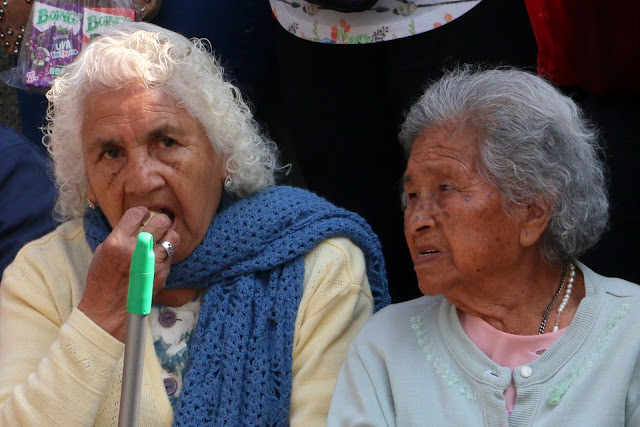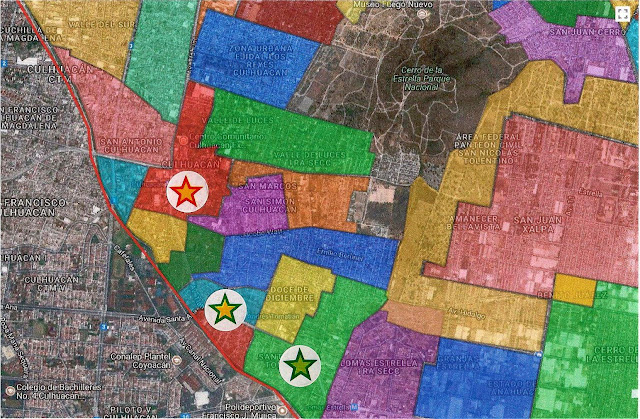We have been to Culhuacán a number of times. In our first post on the pueblo, we presented its history as one of the oldest continuously occupied pueblos within what is now Mexico City, stretching back at least 2,000 years. In our second post, we took an Amble through Contemporary Culhuacán, seeking vestiges of its ancient history. In our third post, in the process of following a religious procession through several of its barrios, we experienced and described how Culhuacán is now officially divided into two pueblos in two adjacent delegaciones (boroughs).
Scouring the maps of this complex set of pueblos and barrios in order to try to understand their structures and physical relationships, we noted that just south of Pueblo Culhuacán, along the main Avenida Tláhuac (leading to that delegación), there were two more pueblos with indigenous names, San Andrés (St. Andrew, the Apostle) Tomatlán and Santa María (St. Mary) Tomatlan. Curious to explore them, we kept our eyes out for their patron saint fiestas that would give us the opportunity to do so.
Recently, both fiestas arrived close to each other on the calendar of saints' days:
So that Thursday morning, we set off, first by taxi across Avenida Taxqueña, to Avenida Tláhuac and the Culhuacán Metro station. Leaving the train at Estación San Andrés Tomatlán (only one stop south), we step onto the glass-walled, elevated platform and catch sight of the church—a strikingly modern structure with a multi-leveled cathedral ceiling—sitting directly across the avenue from the Metro station exit.
By the time we reach the entrance to the church atrio, the procession has already left. Without our even asking, an elderly woman seated at the base of the church stairs points to her left and tells us that the procession has just gone down a side street and around the corner. We thank her and hurry on.
Following the inimitable sounds of the banda and cohetes (rocket-style firecrackers), we easily catch up with the procession.
- Pueblo San Francisco Culhuacán, in Delegación Coyoacán: West of the National Canal (aka La Viga), comprised of four barrios;
- Pueblo Culhuacán, in Delegación Iztapalapa: East of the Canal, consisting of five barrios.
Culhuacán's Neighbor: Tomatlán
Scouring the maps of this complex set of pueblos and barrios in order to try to understand their structures and physical relationships, we noted that just south of Pueblo Culhuacán, along the main Avenida Tláhuac (leading to that delegación), there were two more pueblos with indigenous names, San Andrés (St. Andrew, the Apostle) Tomatlán and Santa María (St. Mary) Tomatlan. Curious to explore them, we kept our eyes out for their patron saint fiestas that would give us the opportunity to do so.
Recently, both fiestas arrived close to each other on the calendar of saints' days:
- San Andrés' feast day is November 30; and
- Santa Maria de la Concepción Imaculata (St. Mary's Immaculate Conception) is on December 8.
So that Thursday morning, we set off, first by taxi across Avenida Taxqueña, to Avenida Tláhuac and the Culhuacán Metro station. Leaving the train at Estación San Andrés Tomatlán (only one stop south), we step onto the glass-walled, elevated platform and catch sight of the church—a strikingly modern structure with a multi-leveled cathedral ceiling—sitting directly across the avenue from the Metro station exit.
From the platform, we see activity in front of the church: a flower-bedecked anda (portable platform) bearing the statue of a saint; a banda, whose music we can hear, and a small group of people.
Obviously, the procession is about to start. So we hurry down the escalator and cross the busy avenue. We climb one flight of stairs from the street up to the church, then another within the iron-gated church atrio (atrium). The church sits on the edge of the incline leading up Cerro de la Estrella (Hill of the Star), that ancient sacred site whose summit is visible southeast of the church.
Obviously, the procession is about to start. So we hurry down the escalator and cross the busy avenue. We climb one flight of stairs from the street up to the church, then another within the iron-gated church atrio (atrium). The church sits on the edge of the incline leading up Cerro de la Estrella (Hill of the Star), that ancient sacred site whose summit is visible southeast of the church.
The Procession
By the time we reach the entrance to the church atrio, the procession has already left. Without our even asking, an elderly woman seated at the base of the church stairs points to her left and tells us that the procession has just gone down a side street and around the corner. We thank her and hurry on.
Following the inimitable sounds of the banda and cohetes (rocket-style firecrackers), we easily catch up with the procession.
 |
| San Andrés, St. Andrew, the Apostle of Jesus |
The procession has stopped in front of a simple, but modern house with a spacious, tree-shaded entry area behind its open gates. We note that a recent model Cadillac is parked in the carport to the rear, along with another recent model suburban. This is not a working-class home, which frankly surprises us because Culhuacán, as far as we know it, is very much a working-class area of the city.
As the procession leaves, we glimpse other equally upper-middle-class homes behind gated entrances, adding to our curiosity about the pueblo's economic and socio-cultural nature—a curiosity already triggered by the architecturally striking, modern church with its multi-level cathedral ceilings.
The procession, however, soon turns a corner and heads uphill into the pueblo. On this street, the homes and shops are typical of a barrio popular, a working-class neighborhood. Apparently, the first street is a rather anomalous enclave within San Andrés Tomatlán.
At this point the procession turns back down hill, toward the church and Avenida Tláhuac. We don't know whether it will be making more stops, or even crossing traffic-filled Tláhuac to pass through the streets of Pueblo San Andrés on its other side.
But it is well past noon and we are tired, so we take the opportunity to thank the mayordomia, the commitee members, identifiable by their bright pink polo shirts, for letting us share in their communal tradition. With a sincere "hasta luego", until next time, we take our leave.
We tell the mayordomia that we hope to return over the weekend for other events in la Fiesta de San Andrés Tomatlán, most especially el traslado del Señor del Calvario, the transfer of the Lord of Calvary, who is now in the Church of San Andrés during the fiesta, to Pueblo Santa María, just a few blocks down Avenida Tláhuac.
We have encountered el Señor del Calvario twice before:
We have read about His visits to each barrio in Culhuacán for its fiesta. We have now learned that these visits include the two adjacent pueblos of Tomatlán. So we look forward to witnessing and participating in His transfer from San Andrés to Santa María the first of next week.
Procession Through el Pueblo
As the procession leaves, we glimpse other equally upper-middle-class homes behind gated entrances, adding to our curiosity about the pueblo's economic and socio-cultural nature—a curiosity already triggered by the architecturally striking, modern church with its multi-level cathedral ceilings.
The procession, however, soon turns a corner and heads uphill into the pueblo. On this street, the homes and shops are typical of a barrio popular, a working-class neighborhood. Apparently, the first street is a rather anomalous enclave within San Andrés Tomatlán.
 |
| The procession climbs the base of Cerro de la Estrella, on which Pueblo San Andrés Tomatlán rests. |
 |
| The essential cohetero leads the way, announcing the approach of the procession. |
 |
| La Banda brings up the rear, providing the rhythm and impetus for the procession to move on. Papel picado, cut paper, is in San Andrés' colors. |
 |
| Narrow calleja, typical of traditional barrios. |
Offerings to San Andrés and His People
 |
| Enjoying la comida |
 |
| The procession moves on. Abarrotes are groceries. The small shop is typical. Operated at the front of a family home, it serves the neighborhood as a kind of convenience store. |
 |
| The final family visited. We found the elderly couple and their attentive daughter to be both beautiful and poignant. |
 |
| Present, but absent, was our sense of this elderly couple. |
 |
| The procession now heads back downhill toward Avenida Tláhuac. |
Saying "Hasta Luego", Until Next Time
At this point the procession turns back down hill, toward the church and Avenida Tláhuac. We don't know whether it will be making more stops, or even crossing traffic-filled Tláhuac to pass through the streets of Pueblo San Andrés on its other side.
But it is well past noon and we are tired, so we take the opportunity to thank the mayordomia, the commitee members, identifiable by their bright pink polo shirts, for letting us share in their communal tradition. With a sincere "hasta luego", until next time, we take our leave.
 |
| La Mayordomía, the organizing committee. The man at the left is the mayordomo, the head. |
Coming Events: The Lord of Calvary Moves On
We tell the mayordomia that we hope to return over the weekend for other events in la Fiesta de San Andrés Tomatlán, most especially el traslado del Señor del Calvario, the transfer of the Lord of Calvary, who is now in the Church of San Andrés during the fiesta, to Pueblo Santa María, just a few blocks down Avenida Tláhuac.
We have encountered el Señor del Calvario twice before:
In his own chapel, constructed by el pueblo (not by the official Catholic Church) at the very center of Culhuacán;
and at the center of the celebration of Holy Trinity Sunday in June, in which all the barrios of Culhuacán, both those in Coyoacán and those in Iztapalapa, participate.We have come to realize that el Señor del Calvario is the preeminent saint of all Culhuacán, and he performs a role in the religión popular (people's religion) that we have seen in other delegaciones:
el Señor de Misericordia, the Lord of Compassion, in central Coyoacán; and
el Niño 'Pa in Xochimilco.In Culhuacán, el Señor del Calvario is the symbolic, unifying center of the pueblo's traditional identity.
We have read about His visits to each barrio in Culhuacán for its fiesta. We have now learned that these visits include the two adjacent pueblos of Tomatlán. So we look forward to witnessing and participating in His transfer from San Andrés to Santa María the first of next week.
 |
| Delegaciones of Mexico City Iztapalapa is the large, bright green one on the mid-east side. |
 |
| Pueblos, Barrios and Colonias of Iztapalapa. Tomatlán is marked by the green/yellow star. |






No comments:
Post a Comment